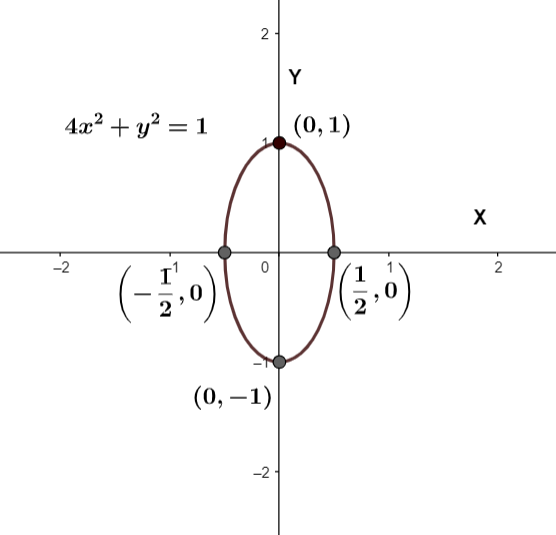
How do you find the center and vertices of the ellipse \[4{{x}^{2}}+{{y}^{2}}=1\]?
Answer
440.1k+ views
Hint: The standard form of equation of ellipse is \[\dfrac{{{x}^{2}}}{{{a}^{2}}}+\dfrac{{{y}^{2}}}{{{b}^{2}}}=1\]. And a, b are any real numbers. As we can see that here the coefficients of the square terms are in the denominator, so to find the center and vertices using the equation, we first have to take the coefficient of the \[{{x}^{2}}\] in the denominator. The vertices are similar to the intercepts of the ellipse. The centre of the ellipse with the equation \[\dfrac{{{x}^{2}}}{{{a}^{2}}}+\dfrac{{{y}^{2}}}{{{b}^{2}}}=1\] is \[x=0\And y=0\].
Complete step by step solution:
We are given the equation of the ellipse as \[4{{x}^{2}}+{{y}^{2}}=1\]. Comparing it with the standard form of the equation \[\dfrac{{{x}^{2}}}{{{a}^{2}}}+\dfrac{{{y}^{2}}}{{{b}^{2}}}=1\], we get \[{{a}^{2}}=\dfrac{1}{4}\And {{b}^{2}}=1\]. Taking the square root of both these equations to find the values, we get \[a=\dfrac{1}{2}\And b=1\].
We know that to find the center of the ellipse, we have to equate the x and y with zero. Thus, we get coordinates of centre as \[(0,0)\].
The vertices are the intercepts of the ellipse; thus, we can find them by substituting x and y to be zero separately.
Substituting \[x=0\], we get
\[\begin{align}
& \Rightarrow 4{{(0)}^{2}}+{{y}^{2}}=1 \\
& \Rightarrow {{y}^{2}}=1 \\
\end{align}\]
Solving the above equation, we get \[y=\pm 1\]. Thus, the coordinates of the two vertices are \[\left( 0,1 \right)\And \left( 0,-1 \right)\].
Substituting \[y=0\],
\[\begin{align}
& \Rightarrow 4{{x}^{2}}+{{0}^{2}}=1 \\
& \Rightarrow 4{{x}^{2}}=1 \\
\end{align}\]
Solving the above equation, we get \[x=\pm \dfrac{1}{2}\]. Thus, the coordinates of the other two vertices are \[\left( \dfrac{1}{2},0 \right)\And \left( -\dfrac{1}{2},0 \right)\].
We can graph the ellipse as,

Note: Here, as the coefficient of the \[{{x}^{2}}\] was not of the form of \[\dfrac{1}{{{a}^{2}}}\]. We have to equate this with the given coefficient, to find the value of the a. we can do this as, \[\dfrac{1}{{{a}^{2}}}=4\]. Thus, on solving this equation, we get \[a=\dfrac{1}{2}\].
Complete step by step solution:
We are given the equation of the ellipse as \[4{{x}^{2}}+{{y}^{2}}=1\]. Comparing it with the standard form of the equation \[\dfrac{{{x}^{2}}}{{{a}^{2}}}+\dfrac{{{y}^{2}}}{{{b}^{2}}}=1\], we get \[{{a}^{2}}=\dfrac{1}{4}\And {{b}^{2}}=1\]. Taking the square root of both these equations to find the values, we get \[a=\dfrac{1}{2}\And b=1\].
We know that to find the center of the ellipse, we have to equate the x and y with zero. Thus, we get coordinates of centre as \[(0,0)\].
The vertices are the intercepts of the ellipse; thus, we can find them by substituting x and y to be zero separately.
Substituting \[x=0\], we get
\[\begin{align}
& \Rightarrow 4{{(0)}^{2}}+{{y}^{2}}=1 \\
& \Rightarrow {{y}^{2}}=1 \\
\end{align}\]
Solving the above equation, we get \[y=\pm 1\]. Thus, the coordinates of the two vertices are \[\left( 0,1 \right)\And \left( 0,-1 \right)\].
Substituting \[y=0\],
\[\begin{align}
& \Rightarrow 4{{x}^{2}}+{{0}^{2}}=1 \\
& \Rightarrow 4{{x}^{2}}=1 \\
\end{align}\]
Solving the above equation, we get \[x=\pm \dfrac{1}{2}\]. Thus, the coordinates of the other two vertices are \[\left( \dfrac{1}{2},0 \right)\And \left( -\dfrac{1}{2},0 \right)\].
We can graph the ellipse as,

Note: Here, as the coefficient of the \[{{x}^{2}}\] was not of the form of \[\dfrac{1}{{{a}^{2}}}\]. We have to equate this with the given coefficient, to find the value of the a. we can do this as, \[\dfrac{1}{{{a}^{2}}}=4\]. Thus, on solving this equation, we get \[a=\dfrac{1}{2}\].
Recently Updated Pages
Master Class 11 Accountancy: Engaging Questions & Answers for Success

Glucose when reduced with HI and red Phosphorus gives class 11 chemistry CBSE

The highest possible oxidation states of Uranium and class 11 chemistry CBSE

Find the value of x if the mode of the following data class 11 maths CBSE

Which of the following can be used in the Friedel Crafts class 11 chemistry CBSE

A sphere of mass 40 kg is attracted by a second sphere class 11 physics CBSE

Trending doubts
Define least count of vernier callipers How do you class 11 physics CBSE

The combining capacity of an element is known as i class 11 chemistry CBSE

Proton was discovered by A Thomson B Rutherford C Chadwick class 11 chemistry CBSE

Find the image of the point 38 about the line x+3y class 11 maths CBSE

Can anyone list 10 advantages and disadvantages of friction

Distinguish between Mitosis and Meiosis class 11 biology CBSE




